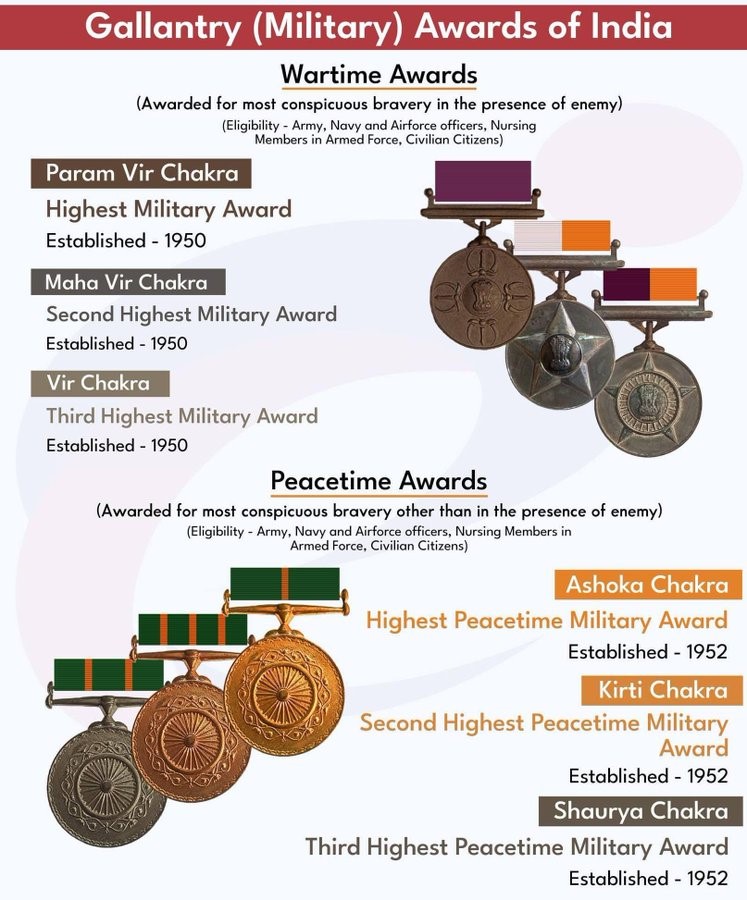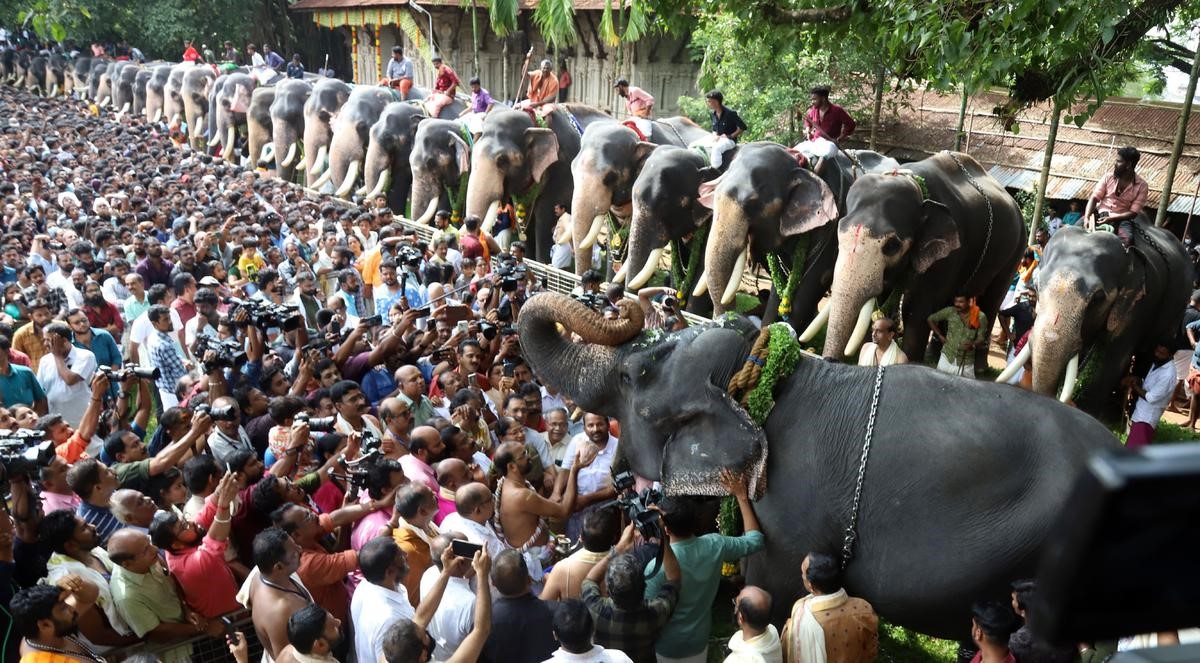- Home
- Prelims
- Mains
- Current Affairs
- Study Materials
- Test Series
July 17, 2024 Current Affairs
1. Gallantry Medal
Haryana seeks gallantry medal for 6 cops.
Gallantry Awards
- Gallantry Awards in India are prestigious honours bestowed upon personnel of the Indian armed forces and occasionally civilians, recognizing their bravery, valor, and sacrifice.
- These awards are given for displaying conspicuous gallantry, indomitable courage, and extreme devotion to duty.
- The President of India confers these awards in the name of the Republic of India.

Eligibility
The following categories of persons shall be eligible for the Param Vir Chakra, the Maha Vir Chakra and the Vir Chakra:
- Officers and men and women of all ranks of the Naval, Military and Air Forces, of any of the Reserve Forces, of the Territorial Army, Militia and of any other lawfully constituted Armed Forces.
- Matrons, Sisters, Nurses and the Staff of the Nursing Services and other Services pertaining to Hospitals and Nursing, and Civilians of either sex serving regularly or temporarily under the orders, directions or supervision of any of the above-mentioned Forces.
Conditions of Eligibility
- The Param Vir Chakra is awarded for most conspicuous bravery or some daring or pre-eminent act of valour or self-sacrifice, in the presence of the enemy, whether on land, at sea, or in the air.
- The Maha Vir Chakra is awarded for acts of conspicuous gallantry in the presence of the enemy whether on land, at sea or in the air.
- The Vir Chakra is awarded for acts of gallantry in the presence of the enemy, whether on land or at sea or in the air.
The following categories of persons shall be eligible for the Ashoka Chakra, the Kirti Chakra and the Shaurya Chakra:
- Officers and men and women of all ranks of the Army, the Navy and the Air Force, of any of the Reserve Forces, of the Territorial Army, Militia and of any other lawfully constituted forces.
- Members of the Nursing Services of the Armed Forces.
- Civilian citizens of either sex in all walks of life and members of Police Forces including Central Para-Military Forces and Railway Protection Force.
Conditions of Eligibility:
- The Ashoka Chakra is awarded for most conspicuous bravery or some act of daring or pre-eminent act of valour or self-sacrifice otherwise than in the face of the enemy.
- The Kirti Chakra is awarded for conspicuous gallantry otherwise than in the face of the enemy.
- The Shaurya Chakra is awarded for gallantry otherwise than in the face of the enemy.
- All the gallantry awards may be awarded posthumously.
- Persons recommended for the award shall not be involved in any adverse report or should not have been conveyed any displeasure or censure or given any punishment in a court martial proceeding or through administrative action.
2. Aanayoottu: an annual elephant feeding ritual held at the Sree Vadakkunnathan Temple, Thrissur
What is Anayoottu?
- The Aanayoottu (gaja pooja/ feeding of elephants) is a festival held in the precincts of the Vadakkunnathan temple in City of Thrissur, in Kerala.
- The festival falls on the first day of the month of Karkkidakam (timed against the Malayalam calendar), which coincides with the month of July.
- It involves a number of unadorned elephants being positioned amid a multitude of people for being worshipped and fed.
- Crowds throng the temple to feed the elephants.
Historical Background:
- Kerala’s elephant pooram was selected for display at the opening ceremony of the Asian Games held in Delhi in 1982.
- It was a herculean task to transport the elephants all the way to Delhi.
- A large team accompanied 34 majestic elephants to Delhi.
- This long journey made many elephants sick and weak so to help them regain health, Anayoottuwas started where special nutritious food was fed to the pachyderms.

Vadakkunnathan temple
The Vadakkunnathan temple is the first temple which was created by Lord Parasurama. The temple located at the heart of the city of Thrissur is enclosed by colossal walls of stone under an area of around eight acres. The four directions, East, West, North and South in the temple have been indicated by four Gopurams inside the temple premises. In the centre of the temple there is multi shrined complex, besides the four Gopurams. The three key shrines of the temple have been dedicated to the Vadakkunnathan or Lord Shiva, Lord Rama and Sankaranarayana.
3. Indian flap shell turtle
A vulnerable Indian flap shell turtle with a cracked shell was discovered in Budaun, possibly from a vehicle collision, and brought to the Indian Veterinary Research Institute for care.
Indian flap shell Turtle:
It is a freshwater species of turtle found in South Asia. The "flap-shelled" name stems from the presence of femoral flaps located on the plastron. These flaps of skin cover the limbs when they retract into the shell. It is morphologically an evolutionary link between the softshell and hard-shell aquatic turtles.
Habitat: They live in the shallow, quiet, often stagnant waters of rivers, streams, marshes, ponds, lakes and irrigation canals, and tanks. These turtles prefer waters with sand or mud bottoms because of their tendency to burrow.
Distribution: They are mainly found in Pakistan, India, Sri Lanka, Nepal, Bangladesh (Indus and Ganges drainages), and Myanmar (Irrawaddy and Salween Rivers).
Lifestyle: They are omnivores. They are generally solitary and active during the day. They are very well adapted, both morphologically and behaviourally, to drought conditions.
Conservation status
IUCN Red list: Vulnerable
CITES: Appendix I
Wildlife (Protection) Act, 1972: Schedule I
4. Wolbachia
Wolbachia is a gram-negative bacterium known for its diverse interactions with arthropods and nematodes. It can act as a parasite or mutualistic microbe, impacting host reproduction and survival significantly.
How Does the Wolbachia Method Work
- Egg Injection: Wolbachia bacteria is injected into the eggs of Aedes aegypti mosquitoes. Thereafter, they are released into the wild.
- Larval Exposure: Wolbachia bacteria is introduced into Larvae by exposing it to Wolbachia-infused water.
- Male Releases: This method involves releasing Wolbachia-infected male mosquitoes into the wild. These male mosquitos then mate with wild female mosquitos, passing on the bacteria to their offspring.
Advantages of Wolbachia
- The flies and mosquitos infected with Wolbachia bacteria are more resistant to RNA viruses such as West Nile virus, Chikungunya virus, cricket paralysis virus, flock house virus and Norovirus.
- In leaf miners, the bacteria help their hosts to produce green islands. The leaf miners are insects that lives and easts the leaf tissues in their larval stage. The Wolbachia bacteria help the leaf miners to produce green islands on the leaves that are yellowing. This allows the larva to grow to their adult forms.
- It helps in iron metabolism in some of the insect species.
- The occurrence of Wolbachia in household mosquitos help them remain resistant to insecticides.
- The Wolbachia induce fecundity in some of their hosts. Fecundity is fertility selection. It is the fitness advantage that increase the number of offspring.
5.Kangaroo Courts
- It is defined as an unofficial court managed by a group of people to try someone as guilty even without good evidence.
- It ignores acknowledged standards of law or justice.
- The first kangaroo courts originated in the United States in 1849.
- It was first mentioned in 1853 in a book in the USA.
- It undermines the importance of the Judiciary and poses a serious challenge to the law and order situation.
- It also goes against the principle of “Rule of Law”.
Issues:
- The system does not work on the standards of law or justice.
- In Kangaroo Court, the procedure is only conducted as a formality.
- Kangaroo Courts are known for working against the phrase” innocent until proven guilty”.
- The court does not allowto appeal against its judgement.
6. Internationalisation of the Rupee
A Reserve bank of India -appointed working group recommended inclusion of the rupee in the Special Drawing Rights (SDR) basket and recalibration of the foreign portfolio investor (FPI) regime to accelerate the pace of international of the rupee.
Advantages of Internationalisation of the Rupee
- Currency risk is reduced for Indian enterprises when using the rupee in international dealings. It is the ability to effectively build a business while being protected from currency volatility which will increase the likelihood that Indian companies will expand internationally.
- De facto domestic tightening occurs as a result of excessive foreign currency liabilities of domestic businesses. Significantly lessening one’s exposure to currency risk would lessen the impact of capital flow reversals.
- The requirement for maintaining foreign exchange reserves decreases. Reserves have an impact on the economy even though they help control exchange rate volatility and project external stability.
- India becomes less susceptible to outside shocks by reducing its reliance on foreign money.
- Improved rupee acceptability and commerce would give Indian companies more negotiating leverage, which would weigh down the Indian economy and raise India’s standing and respect around the world. This would allow India to diversify its trading basket and avoid western sanctions and limitations. To avoid sanctions:
- The value of the rupee will increase with its internationalisation. In other words, it will increase demand for the rupee in global trade.
Challenges in Internationalisation of Rupee
- It results in the Trilemma of an open economy, which states that no nation can pursue the objectives of unrestricted capital flow, stable exchange rates, and independence from external financial influence at the same time.
- Increased refinancing risk as a result of the rupee holdings of non-residents worsening the risks associated with the external stimulus that is transferred to local financial markets.
- Increased volatility of the rupee’s exchange rate (value) in the event that global inflation exceeds local inflation or as a result of unchecked capital flows.









 Latest News
Latest News
 General Studies
General Studies